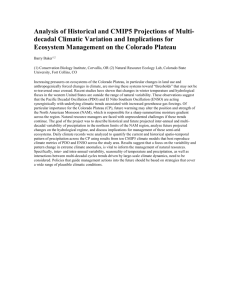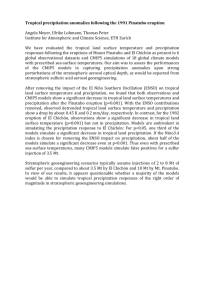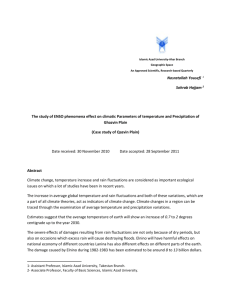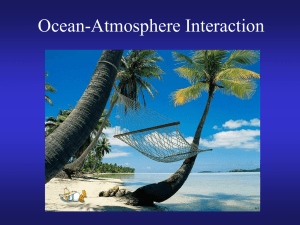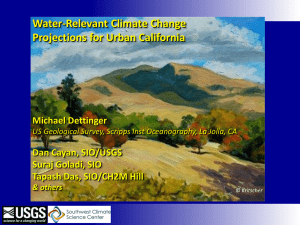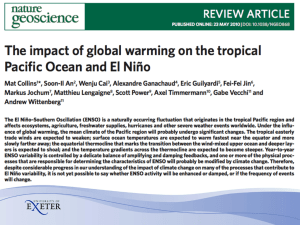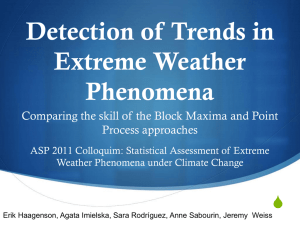Reason_IPCC_5AR_Ugandas Climate_Change and
advertisement
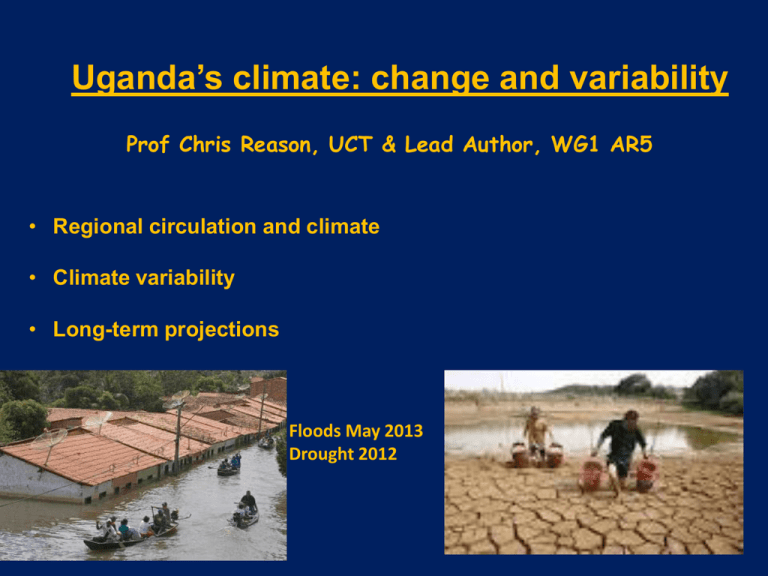
Uganda’s climate: change and variability Prof Chris Reason, UCT & Lead Author, WG1 AR5 • Regional circulation and climate • Climate variability • Long-term projections Floods May 2013 Drought 2012 Seasonal movements in the ITCZ control rainfall over East Africa The ITCZ crosses the equator twice a year => OND & MAM rainy seasons East African highlands and gaps (e.g. Turkana) exert strong Influences on regional rainfall Turkana Jet N Hem summer Asian monsoon Extent of Hadley and Walker cells are important for tropical circulation and rainfall. The tropical Walker circulation is expected to weaken. Extent of Hadley and Walker cells are important for tropical circulation and rainfall. The tropical Walker circulation is expected to weaken. Hadley Cell projected to shift polewards , generally tropics expected to get wetter and subtropics drier. There is medium confidence that an increase in seasonal mean rainfall on the equatorward flank of the ITCZ will occur by the end of the century Climate modes important for East Africa • • • • El Nino Southern Oscillation (ENSO) - SONDJF Indian Ocean Dipole (IODZM) – OND MJO – variability within rainy season – 20-70 day timescale ENSO and IOD are projected to remain dominant. MJOs are not well represented in models so difficult to project changes Why is climate variability important when considering climate change & development? • East Africa’s food security, health of population and agricultural resources, power generation and GDP are strongly influenced by ENSO and the IOD • Since ENSO & IOD are projected to remain dominant in future climate scenarios, it is crucial to understand them and how they may vary on decadal scales and longer • Example of Lake Victoria and 1961 IOD induced floods • Recent droughts and floods Dramatic Drop in Lake Victoria Level – courtesy Fred Semazzi “no trend” pre-1961 lake levels climate variability or excessive release? ENSO-IOZM excessive release? Drought? Recent rainy seasons: OctDec 2013, Mar-May 2014, MayJul 2014 SST anomaly Jul/Aug 2014 2006 and 2009 coastal flooding: ENSO / IOD Gamoyo et al (2014) Projections for the Future • Indian Ocean SST and regional precipitation • ENSO • Global SST and precipitation • Temperature and precipitation extremes Figure 14.10: September to November changes in a 22-model CMIP5 ensemble ( 2081– 2100 in RCP8.5 minus 1900–1949 in historical run). (a) SST (colour contours at 0.1°C intervals) relative to the tropical mean (20°S–20°N), and precipitation (shading and white contours at 20 mm per month intervals). (b) Surface wind velocity (m/s), and sea surface height deviation from the global mean (contours, cm). Over the equatorial Indian Ocean, ocean-atmospheric changes are in positive Bjerknes feedback, with the reduced SST warming and suppressed convection in the east. Projected weaker variances during IOD occur in both zonal wind and thermocline depth. El Nino and IOD-like anomalies by the end of the century relative to the end of the previous century ENSO & projected changes in the tropical Pacific Projected 21st century changes in annual mean and annual extremes (over land) of surface air temperature and precipitation: (a) mean surface temperature per oC of global mean change, (b) 90th percentile of daily maximum temperature per oC of global average maximum temperature, (c) mean precipitation (in % per oC of global mean temperature change), and (d) fraction of days with precipitation exceeding the 95th percentile. Panels (a) and (c) projected changes in means between 1986-2005 and 2081-2100 from CMIP5 simulations under RCP4.5 scenario; Panels (b) and (d) projected changes in extremes over land between !980-1999 and 2081-2100 . Light hatching denotes where more than 66% of models (or members) have the same sign with the ensemble mean changes, while dense hatching denotes where more than 90% of models (or members) have the same sign with the ensemble mean changes. Downscaled CMIP5 projections for particular stations www.csag.uct.ac.za Summary • It is very likely that all of Africa will continue to warm during the 21st century. Equatorial Africa (including East Africa) is projected to warm less than either southern Africa or North Africa • In general, tropics are expected to get wetter and subtropics drier. However, for East Africa, there is medium confidence in model projections for little change in mean annual precipitation. Increased rainfall is likely for the short rains but there is low confidence in projections for the long rains. • There is high confidence that ENSO will remain the dominant mode of natural climate variability in the 21st century but changes in intensity are uncertain. IOD is very likely to remain active throughout 21st century – this together with enhanced warming in the western Indian Ocean affects climate extremes in East Africa and increases precipitation during the short rains season
